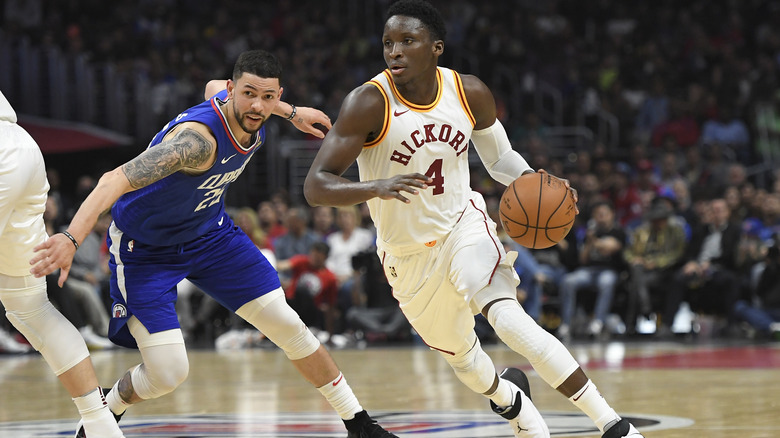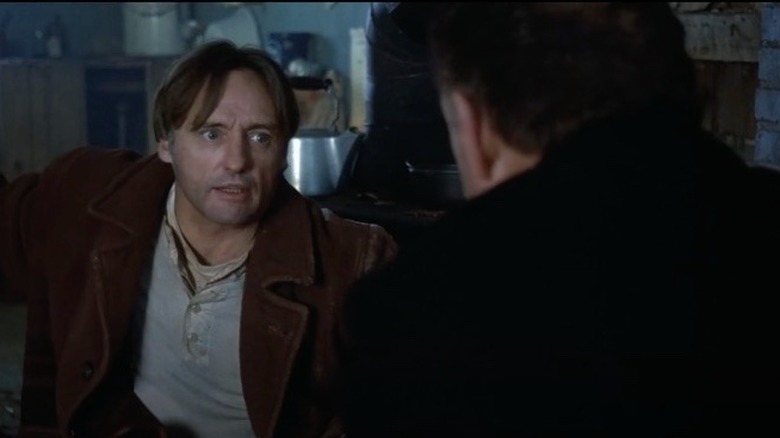How Historically Accurate Is Hoosiers?
When it comes to movies that are supposedly based on a true story, one has to ask the question at some point — is the film historically accurate? Sometimes, certain events are exaggerated for the sake of adding fuel to the dramatic fire, and in the interest of simplifying things for the average viewer, writers can create composite characters by taking the most interesting aspects and traits of various real-life people and assigning them to one individual, usually with a fictional name. That seems to be especially true with sports movies of this kind, where the tropes are just as plentiful as the improbable last-second, nail-biter victories.
Still, that doesn't stop some of them from turning out to be classics. 1986's "Hoosiers" is one such film, as it tells the story of a high school basketball team from small-town Indiana that shocks everybody by winning the state championship against a much more formidable opponent. Lacking in size and manpower and led by a former college coach with a controversial past, the Huskers of Hickory High School become folk heroes thanks to that shocking win, but it doesn't come easy, may it be for the coach or for his players.
"Hoosiers" is loosely based on a true story, and we should emphasize that the operative word here is "loosely." We'll go into much greater detail below, but we hope that won't interfere with your enjoyment of the film.
There's no such school as Hickory High ... nor a town called Hickory, Indiana
When talking about the historical accuracy of "Hoosiers," there's no better place to start than the name of the Indiana town and the high school of the same name that's at the center of the story. Chances are a lot of you may have thought that both the town and the school exist — heck, the Indiana Pacers launched Hickory-themed alternate jerseys ahead of the 2015-16 NBA season, doing so in commemoration of the 30th anniversary of "Hoosiers" and as a tribute to Indiana's rich basketball history. (That's Victor Oladipo in the picture above, driving to the hoop in his Hickory uniform — given that he played college ball for the Indiana Hoosiers, there couldn't have been a better man to rock those jerseys.)
But what if we told you that the town of Hickory does not actually exist? According to ESPN, there is no such town as Hickory, Indiana, nor a Hickory High Huskers, and there never was back in the early '50s. Both are stand-ins for the real-life town of Milan, Indiana, and its pride, the Milan High Indians. The similarities, however, are there. Hickory and Milan are both small towns, and though the movie takes place just a few years before the real-life event that inspired it, the story still happens in the early 1950s — Hickory won the Indiana state title in 1952, Milan won it in 1954.
Milan High's coach was a young man; Gene Hackman wasn't
Sometimes, it just makes the most sense to hire an actor who's a natural for the part they'll be playing. That seems to have been the rationale behind Gene Hackman's casting as Hickory High's gruff new coach, Norman Dale. At the time "Hoosiers" was released, Hackman was 56 years old and a grizzled Hollywood veteran best known for playing tough law enforcement officers like Popeye Doyle in "The French Connection" and military men in multiple films. And let's not forget his role as Lex Luthor in the Christopher Reeve "Superman" films. He just seemed like the perfect fit for a former college coach who fell from grace after punching one of his players.
The person Dale was mainly based on, Milan High coach Marvin Wood, was only 26 years old and in his second year with the Indians when they won it all in 1954 (via ESPN). But once again, there were some similarities between reel life and real life; Dale and Wood both replaced popular coaches, and they weren't exactly given the rock star treatment by the townspeople. On the other hand, their predecessors' fates were like night and day — Hickory's previous coach had died, while Milan's previous coach, Herman "Snort" Grinstead, was sacked because he defied his superintendent by ordering new uniforms.
Also worth noting is the glaring difference in temperament between Wood and Dale. According to Chasing the Frog, Wood was a soft-spoken man who credited God for the Indians' championship win. Dale, meanwhile, was partly inspired by then-Indiana Hoosiers coach Bobby Knight, a legendary hothead who would, many years later, be accused by one of his former players of punching him in the back of his head, among many other disturbing things.
The underdog narrative was blown up for dramatic purposes
In the world of sports movies and TV shows, there are few things more satisfying than watching a football team lacking in size (or definitely not lacking in behind-the-scenes drama) come from behind to beat a much tougher opponent with a Hail Mary touchdown pass on fourth-and-long, or a star slugger winning the game for his baseball team by scoring a miraculous grand slam in the bottom of the ninth inning. Such a narrative plays out in "Hoosiers," as the Hickory High Huskers are nobodies from nowhere, a ragtag bunch of undersized players who win the title against a state powerhouse on a last-second shot. Huskers win, 42-40, and everyone lives happily ever after.
As anyone who's played (or even just watched) competitive sports may tell you, it takes a perfect storm of circumstances for such a Cinderella story to happen in real life with all those classic sports movie tropes in place. Furthermore, ESPN noted that the Milan High Indians weren't really underdogs in the truest sense as they entered the 1954 state tournament. The year prior, they made it all the way to the semifinals, and during the 1953-54 season, they entered the tourney with an impressive 19-2 record. And while the Indians did eke out a 32-30 win in real life, the ending was far less exciting, at least if seen through the eyes of a modern basketball fan.
As was the style in those pre-shot clock days, there was a lot of stalling in the game's final quarter. And Bobby Plump (more on him below) held on to the ball for one whole minute before hitting the game-winner with 18 seconds left on the game clock. For comparison's sake, Indiana Pacers legend Reggie Miller scored eight points in nine seconds to lead his team to a come-from-behind playoff win against the New York Knicks in 1995.
Jimmy Chitwood's real-life equivalent was a 'very shy kid'
While still on the topic of that game-winning shot, let's zero in on the young man who sank it — in the film, he's named Jimmy Chitwood and he's played by Maris Valainis. Jimmy is portrayed as Hickory High's prodigal son, having left the team ahead of Norman Dale's hiring. He eventually returns with an ultimatum — he'll only suit up if the townspeople change their mind and allow Dale to keep coaching the Huskers. He then confidently says the now-famous words, "I'll make it," as Dale calls a play for the final shot of the championship game.
Speaking to The Washington Post in 1995, Bobby Plump — the inspiration for Jimmy Chitwood — revealed that he was actually a "very shy kid" who wouldn't have made such a guarantee. But even with those added dramatic elements, he admitted that he enjoyed the scene, quipping that he "knew it was going in" when his film equivalent Jimmy attempted the final shot.
Although the shot did make him an Indiana high school legend, Plump's overall shooting clip was forgettable in that 1954 championship game — he went just 3-for-11 from the field. He stayed home for college and averaged nearly 20 points per game as a senior for the Butler Bulldogs (via Sports Reference), though as a 5-foot-11-inch guard for an unheralded independent team, he wasn't selected in the 1958 NBA Draft. He did, however, briefly work for Phillips Petroleum and play for their National Industrial Basketball League team before entering the insurance business.
Hoosiers featured multiple characters who were purely fictional
As is very common in movies that are based on a true story, "Hoosiers" featured a number of completely fictional characters. These included Wilbur "Shooter" Flatch (Dennis Hopper), the town drunk who happens to be the father of one of Norman Dale's Hickory High players. Wanting to give Shooter — a former Hickory standout himself — a second chance in life, Dale recruits him as his assistant, much to the town's chagrin. Per Chasing the Frog, Milan High's Marvin Wood had two assistants, Marc Combs and Clarence Kelly, and neither was the type to get lost in the sauce.
Similarly, "Hoosiers" invokes some romantic tropes by giving the unmarried Dale a love interest in Hickory High teacher Myra Fleener (Barbara Hershey). As Dale continues to annoy the basketball-crazy townspeople with his boring (yet effective) style of play, his questionable personnel decisions (see above), and his on-court temper tantrums, Myra remains firmly on the coach's side, imploring the angry mob to give him another chance when they vote to have him fired. Great story, but again, she didn't have any real-life equivalent — Wood was married with two children.
Interestingly, "Hoosiers" also features another feel-good moment where diminutive team manager Ollie (Wade Schenck) hits two game-winning free throws in the semifinal. Milan did have an Ollie as their manager, though Oliver Jones never saved the day with clutch charities as his fictional version did.





